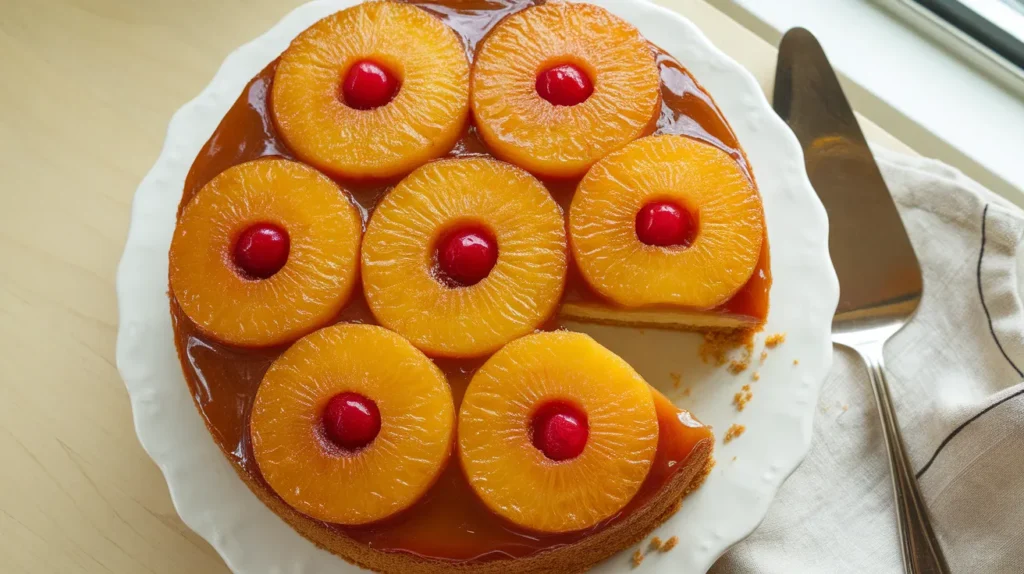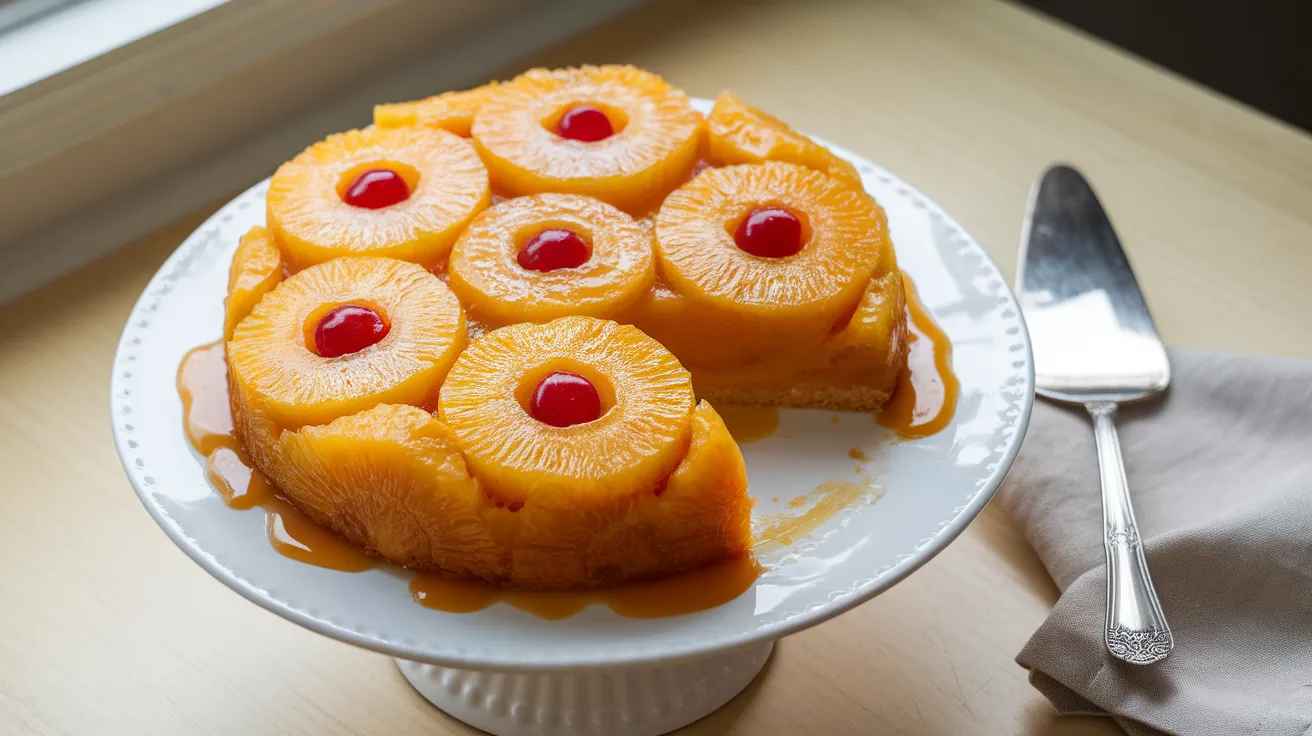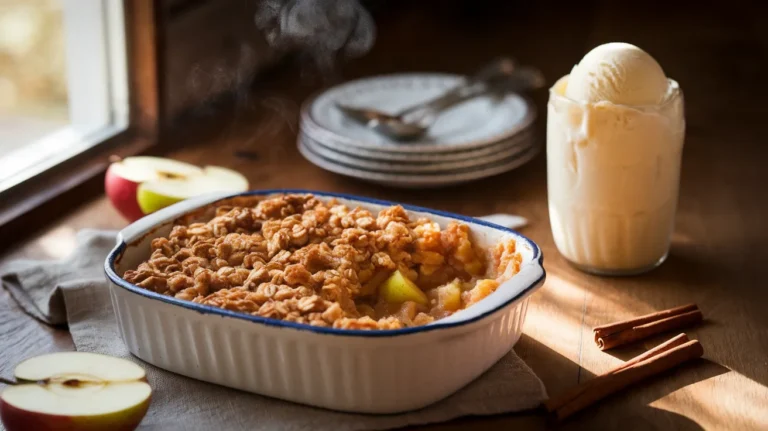This upside down cake transforms simple ingredients into a stunning dessert with caramelized fruit on top and tender cake beneath. Perfect for weekend baking or impressing dinner guests, this upside down cake delivers bakery-quality results right from your home kitchen.
SERVES: 4 | PREP: 20 MIN | COOK: 35 MIN | TOTAL: 55 MIN
What Makes This Upside Down Cake Special
You flip it. That’s the magic.
The fruit cooks on the bottom, caramelizes in butter and sugar, then becomes the gorgeous top when you invert the pan. No fancy piping skills needed.
This recipe uses a smaller 8-inch pan for four servings. The cake stays moist for days, and leftovers actually taste better the next morning with coffee.
Ingredients
For the Topping
| Ingredient | Amount |
|---|---|
| Unsalted butter | 4 tablespoons |
| Light brown sugar | ½ cup (packed) |
| Pineapple rings (canned, drained) | 4-5 rings |
| Maraschino cherries | 4-5 cherries |
For the Cake Batter
| Ingredient | Amount |
|---|---|
| All-purpose flour | 1 cup |
| Baking powder | 1 teaspoon |
| Salt | ¼ teaspoon |
| Unsalted butter (room temp) | 4 tablespoons |
| Granulated sugar | ½ cup |
| Large egg | 1 whole |
| Vanilla extract | 1 teaspoon |
| Whole milk | ⅓ cup |
Step-by-Step Instructions
Phase 1: Prep Work (5 minutes)
Step 1: Set your oven to 350°F. Don’t skip preheating—it ensures even baking from the moment your pan goes in.
Step 2: Get an 8-inch round cake pan. Grease just the sides with butter or cooking spray, but leave the bottom ungreased. This helps the topping release cleanly when you flip it.
Step 3: Take out your butter and egg. They need 30 minutes at room temperature. Cold ingredients create dense cake. If you forgot, microwave the butter for 5-second bursts until soft but not melted.
Phase 2: Creating the Caramel Topping (8 minutes)
Step 4: Melt 4 tablespoons butter in a small saucepan over medium heat. Watch it—butter burns fast. You’ll see it foam, then the foam will subside. That’s your cue.
Step 5: Add ½ cup brown sugar to the melted butter. Stir constantly with a wooden spoon for 2-3 minutes. The mixture will bubble and turn glossy. You’re making caramel, so it should smell nutty and sweet, not burnt.
Step 6: Pour this caramel mixture into your prepared pan. Tilt the pan to spread it evenly across the bottom. Work quickly before it hardens.
Step 7: Arrange pineapple rings in a single layer on the caramel. One in the center, others around it. Press them down gently so they stick to the caramel.
Step 8: Drop a maraschino cherry in the center of each pineapple ring. These create the classic look. Set the pan aside while you make the batter.
Phase 3: Mixing the Cake Batter (7 minutes)
Step 9: Grab a medium bowl. Whisk together 1 cup flour, 1 teaspoon baking powder, and ¼ teaspoon salt. Whisking adds air and prevents lumps. Set this bowl aside.
Step 10: In a large bowl, beat 4 tablespoons softened butter with an electric mixer on medium speed for 1 minute. It should look creamy and lighter in color. This is called creaming, and it creates a fluffy cake.
Step 11: Add ½ cup sugar to the butter. Beat for 2-3 minutes until the mixture looks pale and fluffy, like frosting. Scrape down the sides of the bowl halfway through. This step incorporates air bubbles that make your upside down cake rise properly.
Step 12: Crack in 1 egg and add 1 teaspoon vanilla. Beat until completely combined, about 30 seconds. The mixture might look slightly curdled—that’s normal and will fix itself when you add flour.
Step 13: Add half your flour mixture to the butter mixture. Stir gently with a spatula just until you see streaks of flour. Pour in half the milk (about 2½ tablespoons). Stir until combined.
Step 14: Repeat with remaining flour and milk. Stop mixing the moment you don’t see dry flour. Overmixing creates tough, chewy cake. A few tiny lumps are fine.
Phase 4: Baking (35 minutes)
Step 15: Pour batter over your arranged fruit. Use a spatula to spread it evenly to the edges. Don’t worry if you disturb the fruit slightly—it all settles during baking.
Step 16: Bake for 30-35 minutes. The cake is done when a toothpick inserted in the center comes out clean or with just a few moist crumbs. The top should be golden brown and spring back when touched lightly.
Step 17: Remove from oven. Let it cool in the pan for exactly 10 minutes. This is crucial. Too short and the topping won’t set; too long and the caramel hardens to the pan.
Phase 5: The Big Flip (2 minutes)
Step 18: Run a butter knife around the pan edges to loosen the cake. Place a serving plate face-down on top of the pan.
Step 19: Hold the plate and pan together firmly. Flip them over in one confident motion. Let the pan sit upside-down for 30 seconds—gravity does the work.
Step 20: Lift the pan straight up slowly. If any fruit sticks, use a spatula to gently place it back on the cake. The caramel will still be soft and pliable for adjustments.
Chef’s Notes
Pineapple juice matters. Drain those rings well and pat dry with paper towels. Excess moisture makes the upside down cake soggy and prevents proper caramelization.
Brown sugar creates better caramel than white sugar because the molasses adds depth and helps prevent crystallization. Don’t substitute.
Room temperature ingredients blend faster and create better texture. Cold eggs and butter create lumps that require overmixing to fix, which toughens the crumb.
The 10-minute cooling window is non-negotiable. I’ve tested this upside down cake dozens of times. Less time and the topping slides off; more time and you’ll need a chisel.
Nutrition Per Serving
Calories: 385 | Protein: 4g | Carbs: 58g | Fat: 16g | Fiber: 1g | Sugar: 42g | Sodium: 210mg
Creative Variations to Try
Peach Upside Down Cake: Swap pineapple for fresh peach slices. Arrange them overlapping like fallen dominoes. Add a pinch of cinnamon to the caramel. This version rivals any lemon raspberry cake for spring gatherings.
Apple Cinnamon Version: Use thinly sliced Granny Smith apples. Mix ½ teaspoon cinnamon into your brown sugar topping. Skip the cherries and tuck fresh cranberries between apple slices for holiday flair.
Berry Blast: Cover the caramel with a mix of whole strawberries, blueberries, and blackberries. Reduce milk in the batter by 1 tablespoon since berries release juice. The technique works beautifully, similar to how you’d prepare a pumpkin roll with different fillings.
Tropical Mango: Replace pineapple with fresh mango slices. Add 1 tablespoon coconut to the caramel and use coconut milk instead of regular milk in the batter. Tastes like vacation.
Storage & Reheating
Room temperature: Cover loosely with plastic wrap. Lasts 2 days on the counter. The caramel keeps the cake moist.
Refrigerator storage: Wrap tightly in plastic, then foil. Keeps for 5 days. The cold makes the caramel firm up—let slices sit at room temperature for 15 minutes before serving.
Freezing: Wrap individual slices in plastic wrap, then aluminum foil. Freeze for 3 months. Thaw overnight in the fridge. The texture stays remarkably good.
Reheating: Microwave individual slices for 15-20 seconds. The caramel gets perfectly gooey again. Avoid the oven—it dries out the cake.

Troubleshooting Common Problems
Problem: Topping stuck to pan
Your cake cooled too long or you didn’t grease the sides. Next time, set a timer for those 10 minutes. If it happens, place the pan over low heat for 30 seconds to soften the caramel, then try flipping again.
Problem: Cake is dense and heavy
You overmixed the batter after adding flour, or your ingredients were too cold. Mix just until combined—20-30 strokes maximum once you add flour. Use room temperature everything.
Problem: Fruit sank into batter
The batter was too thin, or you didn’t pat the fruit dry enough. Make sure you’re using packed brown sugar measurements and well-drained fruit. The caramel layer should be thick enough to hold fruit in place.
Problem: Dry, crumbly texture
You overbaked it or used too much flour. Check your cake 5 minutes early next time. Measure flour by spooning it into the measuring cup and leveling off—don’t scoop directly from the bag.
Problem: Caramel is too hard
Your oven ran hot, or you cooked the caramel mixture too long on the stovetop. Use an oven thermometer to verify temperature. Cook the butter-sugar mixture just until combined and glossy, not until darkly colored.
Equipment Essentials
- 8-inch round cake pan (metal works best for even browning)
- Electric hand mixer (or stand mixer)
- Medium mixing bowl (for dry ingredients)
- Large mixing bowl (for wet ingredients)
- Small saucepan (for caramel)
- Wooden spoon (for stirring caramel)
- Rubber spatula (for folding batter)
- Measuring cups and spoons
- Wire whisk
- Toothpick (for doneness testing)
- Serving plate (slightly larger than pan)
Shopping List
Dairy Section
- Unsalted butter (1 stick)
- Whole milk (small carton)
- Large eggs (if you don’t have any)
Baking Aisle
- All-purpose flour
- Granulated sugar
- Light brown sugar
- Baking powder
- Vanilla extract
Canned Goods
- Pineapple rings (20 oz can)
- Maraschino cherries (small jar)
Pantry
- Salt (you probably have this)
Success Secrets
1. Visual doneness cues beat timers. Look for golden edges pulling slightly away from the pan and a center that doesn’t jiggle when you tap the pan gently.
2. The toothpick test needs interpretation. You want moist crumbs, not wet batter. Completely clean means overbaked. A few sticky crumbs clinging to the toothpick is perfect.
3. Flip with confidence. Hesitation causes half-flips and disaster. Practice the motion without the hot pan first if you’re nervous. Quick and decisive wins.
4. Serve slightly warm for maximum impact. The caramel is glossy and pourable, the cake is tender, and your kitchen smells incredible. Cold upside down cake is still good, but warm is magical.
5. Make it a day ahead for stress-free entertaining. This cake actually improves after 24 hours as flavors meld and the crumb sets. Just don’t refrigerate it—room temperature keeps the texture ideal.




